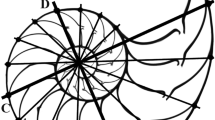Abstract
In up to six different sides along the body axis during tilting manoeuvres, volume shifts into or out off superficial tissues were followed with a newly developed miniature plethysmograph. It was possible to localized a region where no or only minor volume changes during the tilt table experiments occurred. This region is identical with the Hydrostatic Indifferent Point (HIP) being localized below the apex of the heart in the upper third of abdominal vena cava. Above the HIP fluid is drained out off the tissues during assumption of upright posture whereas below the HIP fluid volume is pooled. The volume changes occurred in two phases. Within the first 5 s in the cephalad parts of the body a rapid decrease occurred, thereafter the volume remained unchanged or even increased; below the HIP within the first 5 s a large volume increase was followed by a slow continuous volume increment.
The functional peculiarities of the low pressure system as a whole were visible studying only the superficial shell tissues of the body with the non invasive miniature plethysmographic technique.
Similar content being viewed by others
References
Bevegard, S., Holmgren, A., Jonsson, B.: The effect of body position on the circulation at rest and during exercise, with special reference to the influence on the stroke volume. Acta Physiol. Scand.49, 279–298 (1960)
Brecher, G. A.: Venous return. New York, London: Grune & Stratton 1956
Brechmann, W.: Der hydrostatische Indifferenzpunkt im Venensystem des Menschen. Inaug.-Dissertation, Medizinische Fakultät der Freien Universität Berlin, 1967
Colel, D. R., Kidd, B. S. L., Moffat, W.: The distensibility of blood vessels of the human calf determined by local application of subatmospheric pressures. J. Appl. Physiol.10, 461–468 (1957)
Duomarco, J. L., Rimini, R.: Gradients of pressure in the cardiovascular system. In: Cardiovascular functions (A. Luisada, ed.), pp. 167–173. New York: MacGraw Hill Book Company Inc. 1962
Gauer, O. H., Thron, H. L.: Properties of veins in vivo: Integrated effects of their smooth muscle. Physiol. Rev.42, 283–308 (1962)
Gauer, O. H., Thron, H. L.: Postural changes in the circulation. In: Handbook of physiology, Sect. 2, Circulation, Vol. III (W. F. Hamilton, Ph. Dow, eds.), pp. 2409–2439. Washington, D.C.: American Physiological Society 1965
Guyton, A. C., Greganti, F. P.: A physiologic reference point for measuring circulatory pressures in the dog — particularly venous pressure. Am. J. Physiol.185, 137–141 (1956)
Holt, J. P.: Flow through collapsible tubes and through in situ veins. JEEE Bio. Med. Eng.16, 274–283 (1969)
Kirsch, K. A., Merke, J., Hinghofer-Szalkay, H., Barnkow, M., Wicke, H. J.: A new miniature plethysmography to measure volume changes in small circumscribed tissue areas. Pflügers Arch.383, 189–194 (1980)
Knebel, R., Ockenga, T.: Das Verhalten des zentralen Venendrucks beim Kipptischversuch. Z. Kreisl.-Forsch.49, 235–250 (1960)
v. Kügelgen, A.: Über das Verhältnis von Ringmuskulatur und Innendruck in menschlichen großen Venen. Z. Zellforsch.43, 168 (1955)
Ludbrook, J.: Aspects of venous function in the lower limbs, p. 33. Springfield, Ill.: Ch. C. Thomas 1966
Mellander, S.: Comparative studies on the adrenergic neurohormonal control of resistance and capacitance blood vessels in the cat. Acta Physiol. Scand.50, Suppl. 176, 1–86 (1960)
Sjöstrand, T.: The regulation of the blood distribution in man. Acta Physiol. Scand.26, 312–327 (1952)
Whitney, R. J.: Circulatory changes in the forearm and hand of man with repeated exposure to heat. J. Physiol. (Lond.)125, 1–24 (1954)
Wilkins, R. W., Bradley, S. E., Friedland, C. K.: The acute circulatory effects of the head-down position (negative G) in normal man, with a note on some measures designed to relieve cranial congestion in this position. J. Clin. Invest.29, 940–949 (1950)
Author information
Authors and Affiliations
Additional information
This study was supported by the Bundesministerium für Forschung und Technologie
A preliminary report was given at the 49th Meeting of the German Physiological Society, Göttingen, March 1978 [Pflügers Arch.373, R24, 25 (1978)]
Rights and permissions
About this article
Cite this article
Kirsch, K., Merke, J., Hinghofer-Szalkay, H. et al. Fluid volume distribution within superficial shell tissues along body axis during changes of body posture in man. Pflugers Arch. 383, 195–201 (1980). https://doi.org/10.1007/BF00587518
Received:
Accepted:
Issue Date:
DOI: https://doi.org/10.1007/BF00587518




